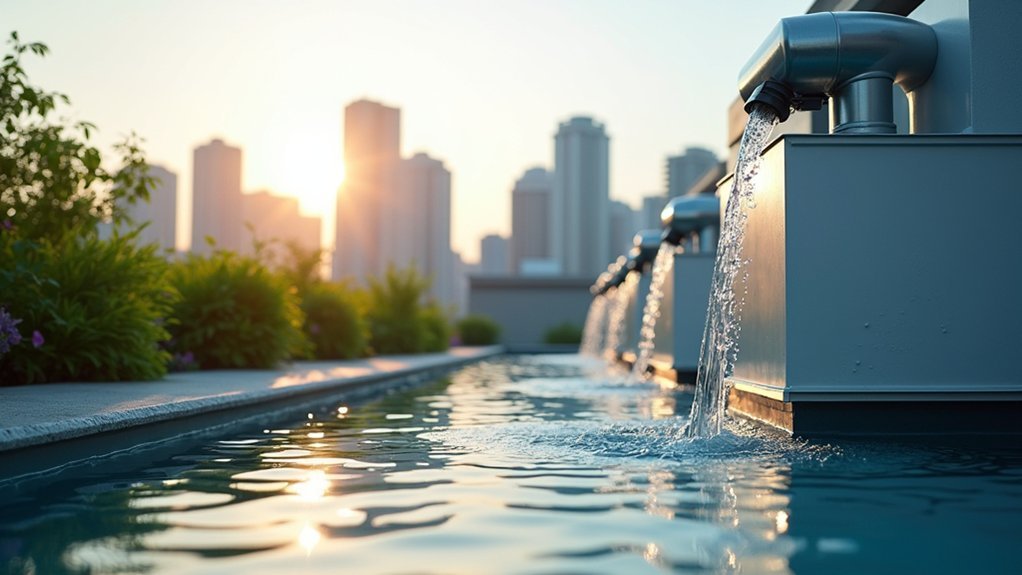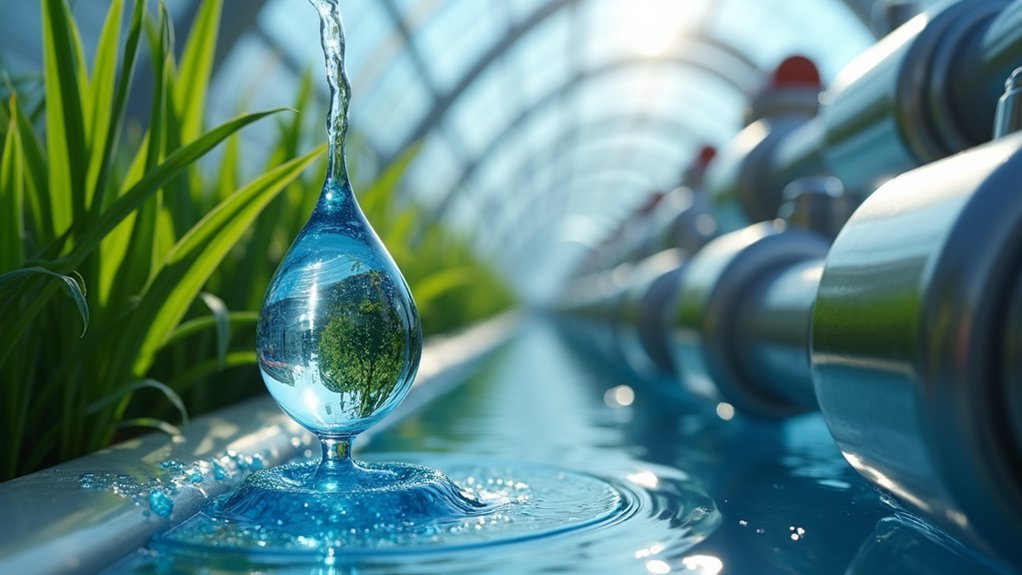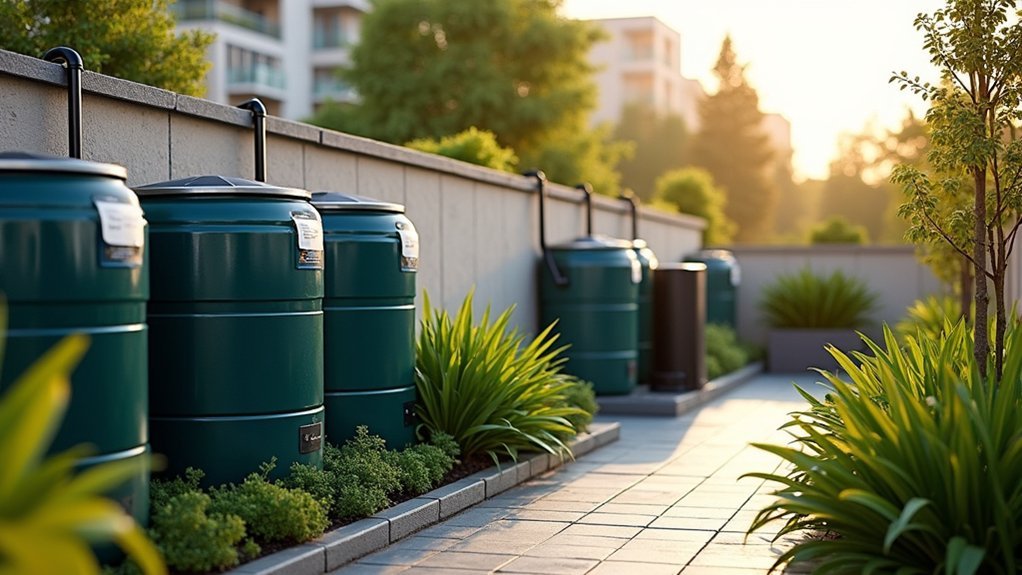The 5 best safe methods to harvest city water include rooftop rainwater collection systems, gravity-fed filtration methods, advanced multi-barrier purification techniques, large-scale storage solutions like underground cisterns, and regulatory-compliant installations. You'll maximize water yield with proper first-flush diverters and regular maintenance of filtration systems. Each approach offers sustainable access to clean water while reducing reliance on municipal supplies. Discover how these methods can be customized to your specific urban environment for ideal results.
Rooftop Rainwater Collection Systems

While many urban dwellers rely solely on municipal water supplies, rooftop rainwater collection systems offer a practical alternative that harnesses nature's free resource.
These rainwater harvesting systems utilize your roof as the primary catchment area, channeling water through gutters and downspouts into storage tanks.
You'll be surprised by the efficiency—just 1 inch of rain falling on 1,000 square feet of roof can yield approximately 623 gallons of clean water.
To guarantee quality, install first-flush diverters that prevent contaminated initial runoff from entering your system.
For storage, you can choose between smaller rain barrels or larger cisterns depending on your needs.
Whatever your setup, don't neglect maintenance—regularly clean gutters and check filtration systems to maintain water purification standards and reduce your dependence on municipal water.
Gravity-Fed Filtration Methods for Urban Water
After setting up your rainwater collection system, you'll need an effective way to purify this water for safe use.
Gravity-fed filtration systems offer an energy-efficient solution for urban water harvesting, using natural forces rather than electricity to process your stored water.
These systems typically include multiple stages: sediment filters that remove larger particles, activated carbon that improves taste, and UV disinfection that eliminates pathogens—transforming harvested rainwater into potable water.
You'll appreciate how easily these filtration systems integrate with existing plumbing systems, requiring minimal modifications.
Advanced Purification Techniques for City Harvested Water

Gravity-fed systems provide a solid foundation, but advanced purification techniques take your harvested water to the next level of safety and quality.
Implementing a multi-barrier approach starts with sediment filtration to remove particles larger than 5 microns, markedly enhancing water quality beyond standard municipal treatment.
After filtering sediment, use activated carbon to eliminate chlorine and organic compounds that affect taste.
For thorough disinfection, UV light systems destroy up to 99.99% of pathogens, while reverse osmosis removes dissolved solids and heavy metals, ensuring your harvested water meets drinking water standards.
Remember that urban water contaminants vary seasonally, so regular maintenance and testing of your purification system is essential.
You'll need to adjust your filtration methods accordingly to maintain ideal water quality year-round during your harvesting efforts.
Large-Scale Water Storage Solutions for Urban Settings
When you're ready to expand your water harvesting capabilities, underground cisterns offer an ideal solution for urban environments where space comes at a premium.
These massive storage tanks can hold thousands of gallons while managing stormwater runoff and preventing urban flooding.
You'll find several innovative approaches to large-scale rainwater collection systems:
- Underground cisterns that capture runoff from rooftops and impervious surfaces
- Above-ground storage tanks that integrate with existing landscaping for irrigation systems
- Modular rainwater collection units that maximize water supply in limited spaces
- Automated monitoring systems that optimize water usage for sustainable urban settings
Compliance With Local Regulations for Water Harvesting

Before installing any rainwater harvesting system, you'll need to navigate the complex landscape of local regulations that govern water collection in urban areas.
Check your municipality's local codes first, as requirements vary greatly between regions. Many areas require permits, especially for larger systems, which must be secured before construction begins.
If you're part of an HOA, you'll find some states like Texas protect your right to harvest rainwater, prohibiting restrictions on these sustainable practices.
Planning to use collected water for potable use? You'll need to comply with strict health department filtration and treatment standards.
Don't overlook potential financial benefits—many municipalities offer incentives and rebates for compliant rainwater harvesting systems, making regulatory compliance not just mandatory but financially advantageous.
Frequently Asked Questions
What Is the Best Method of Water Harvesting?
Rooftop rainwater collection is your best water harvesting method. You'll capture precipitation directly from existing structures. Don't forget to include filtration systems, first-flush diverters, and adequate storage tanks for maximum efficiency.
Why Is Collecting Rainwater Illegal in the US?
Rainwater collection isn't illegal nationwide. You'll find restrictions in some states due to water rights laws, concerns about disrupting natural water cycles, and potential impacts on agricultural and municipal water supplies.
What Is the Most Efficient Way to Collect Rainwater?
You'll collect rainwater most efficiently by installing gutters that channel water from your roof into storage tanks. Don't forget to add first-flush diverters for cleaner water and regularly maintain your system to prevent blockages.
What Is the Best Way to Collect Water?
You'll get the most water by harvesting rainwater from your roof. Install gutters and downspouts that lead to storage tanks, and add filtration systems to guarantee the water is clean for your needs.
In Summary
Harvesting city water can transform your urban living experience while contributing to sustainability. You'll find that proper installation of these five methods guarantees a reliable water supply during shortages. Remember to check your local regulations before implementation, invest in quality filtration, and maintain your system regularly. With these approaches, you're not just conserving a precious resource—you're taking meaningful steps toward water independence in your urban environment.





Leave a Reply